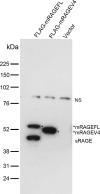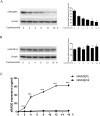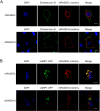Mouse RAGE Variant 4 Is a Dominant Membrane Receptor that Does Not Shed to Generate Soluble RAGE
- PMID: 27655067
- PMCID: PMC5031407
- DOI: 10.1371/journal.pone.0153657
Mouse RAGE Variant 4 Is a Dominant Membrane Receptor that Does Not Shed to Generate Soluble RAGE
Abstract
The receptor for advanced glycation end products (RAGE) is a multi-ligand, immunoglobulin-like receptor that has been implicated in aging-associated diseases. Recent studies have demonstrated that both human and murine Ager genes undergo extensive alternative splicing that generates multiple putative transcripts encoding different receptor isoforms. Except for the soluble isoform (esRAGE), the majority of putative RAGE isoforms remain unstudied. Profiling of murine Ager transcripts showed that variant transcript 4 (mRAGE_v4), the second most abundant transcript in lungs and multiple other tissues, encodes a receptor that lacks nine residues located within the C2 extracellular section close to the trans-membrane domain. We therefore characterized mRAGEV4 isoreceptor in comparison with the full-length mRAGE (mRAGEFL). Although differing in only nine residues, mRAGEFL and mRAGEV4 display very different cellular behaviors. While mRAGEFL undergoes constitutive, extensive shedding in the cell to generate sRAGE, mRAGEV4 hardly sheds. In addition, we found that while mRAGEFL can localize to both the plasma membrane and the endosome, mRAGEV4 is exclusively localized to the plasma membrane. These very different cellular localization patterns suggest that, in addition to their roles in sRAGE production, mRAGEFL and mRAGEV4 may play distinct, spatiotemporal roles in signaling and innate immune responses. Compared to mice, humans do not have the v4 transcript. Although hRAGE, like mRAGEFL, also localizes to the plasma membrane and the endosome, its rate of constitutive shedding is significantly lower. These observations provide valuable information regarding RAGE biology, and serve as a reference by which to create mouse models relating to human diseases.
Conflict of interest statement
The authors have declared that no competing interests exist.
Figures






Similar articles
-
The Mouse-Specific Splice Variant mRAGE_v4 Encodes a Membrane-Bound RAGE That Is Resistant to Shedding and Does Not Contribute to the Production of Soluble RAGE.PLoS One. 2016 Sep 21;11(9):e0153832. doi: 10.1371/journal.pone.0153832. eCollection 2016. PLoS One. 2016. PMID: 27655137 Free PMC article.
-
Effect of insulin on the soluble receptor for advanced glycation end products (RAGE).Diabet Med. 2013 Jun;30(6):702-9. doi: 10.1111/dme.12166. Epub 2013 Apr 4. Diabet Med. 2013. PMID: 23432638
-
Regulation of RAGE splicing by hnRNP A1 and Tra2β-1 and its potential role in AD pathogenesis.J Neurochem. 2015 Apr;133(2):187-98. doi: 10.1111/jnc.13069. Epub 2015 Mar 2. J Neurochem. 2015. PMID: 25689357
-
Alternative splicing of RAGE: roles in biology and disease.Front Biosci (Landmark Ed). 2011 Jun 1;16(7):2756-70. doi: 10.2741/3884. Front Biosci (Landmark Ed). 2011. PMID: 21622207 Review.
-
Low levels of serum soluble receptors for advanced glycation end products, biomarkers for disease state: myth or reality.Int J Angiol. 2014 Mar;23(1):11-6. doi: 10.1055/s-0033-1363423. Int J Angiol. 2014. PMID: 24627612 Free PMC article. Review.
Cited by
-
Mouse Specific Cleavage-Resistant RAGE Splice Variant.PLoS One. 2016 Sep 21;11(9):e0162120. doi: 10.1371/journal.pone.0162120. eCollection 2016. PLoS One. 2016. PMID: 27653772 Free PMC article. No abstract available.
-
The Mouse-Specific Splice Variant mRAGE_v4 Encodes a Membrane-Bound RAGE That Is Resistant to Shedding and Does Not Contribute to the Production of Soluble RAGE.PLoS One. 2016 Sep 21;11(9):e0153832. doi: 10.1371/journal.pone.0153832. eCollection 2016. PLoS One. 2016. PMID: 27655137 Free PMC article.
-
Role and Therapeutic Potential of RAGE Signaling in Neurodegeneration.Curr Drug Targets. 2022;23(12):1191-1209. doi: 10.2174/1389450123666220610171005. Curr Drug Targets. 2022. PMID: 35702767 Free PMC article.
-
Strategies for PET imaging of the receptor for advanced glycation endproducts (RAGE).J Pharm Anal. 2020 Oct;10(5):452-465. doi: 10.1016/j.jpha.2020.07.009. Epub 2020 Aug 4. J Pharm Anal. 2020. PMID: 33133729 Free PMC article.
-
Elevated Expression of the RAGE Variant-V in SCLC Mitigates the Effect of Chemotherapeutic Drugs.Cancers (Basel). 2021 Jun 7;13(11):2843. doi: 10.3390/cancers13112843. Cancers (Basel). 2021. PMID: 34200336 Free PMC article.
References
-
- Neeper M, Schmidt AM, Brett J, Yan SD, Wang F, Pan YC, et al. Cloning and expression of a cell surface receptor for advanced glycosylation end products of proteins. J Biol Chem. 1992;267:14998–15004. - PubMed
-
- Ramasamy R, Vannucci SJ, Yan SS, Herold K, Yan SF, Schmidt AM. Advanced glycation end products and RAGE: a common thread in aging, diabetes, neurodegeneration, and inflammation. Glycobiology. 2005;15:16R–28R. - PubMed
-
- Yonekura H, Yamamoto Y, Sakurai S, Petrova RG, Abedin MJ, Li H, et al. Novel splice variants of the receptor for advanced glycation end-products expressed in human vascular endothelial cells and pericytes, and their putative roles in diabetes-induced vascular injury. Biochem J. 2003;370:1097–1109. - PMC - PubMed
-
- Bucciarelli LG, Wendt T, Qu W, Lu Y, Lalla E, Rong LL, et al. RAGE blockade stabilizes established atherosclerosis in diabetic apolipoprotein E-null mice. Circulation. 2002;106:2827–2835. - PubMed
Grants and funding
LinkOut - more resources
Full Text Sources
Other Literature Sources
Research Materials
Miscellaneous

